2023-2024学年英语鲁教版(五四学制)六年级下册Unit 9 It’s raining! 单元习题课件 (共23张PPT)
文档属性
| 名称 | 2023-2024学年英语鲁教版(五四学制)六年级下册Unit 9 It’s raining! 单元习题课件 (共23张PPT) |

|
|
| 格式 | pptx | ||
| 文件大小 | 162.3KB | ||
| 资源类型 | 教案 | ||
| 版本资源 | 鲁教版 | ||
| 科目 | 英语 | ||
| 更新时间 | 2024-07-05 20:37:51 | ||
图片预览

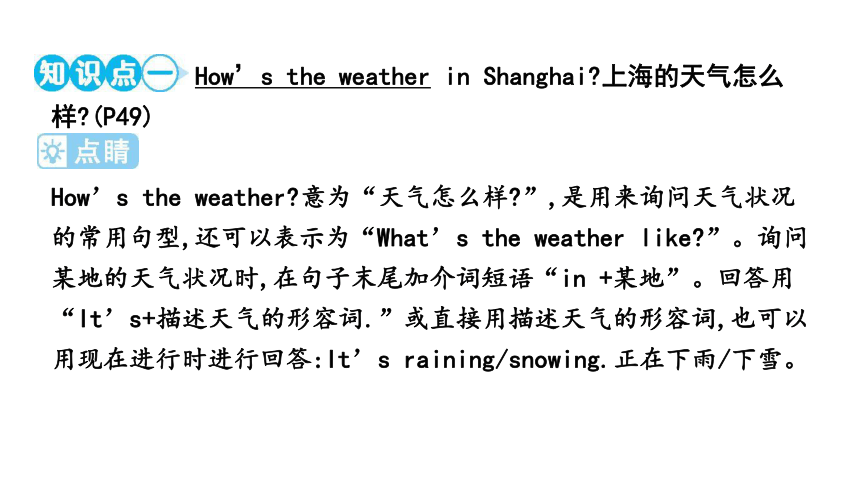
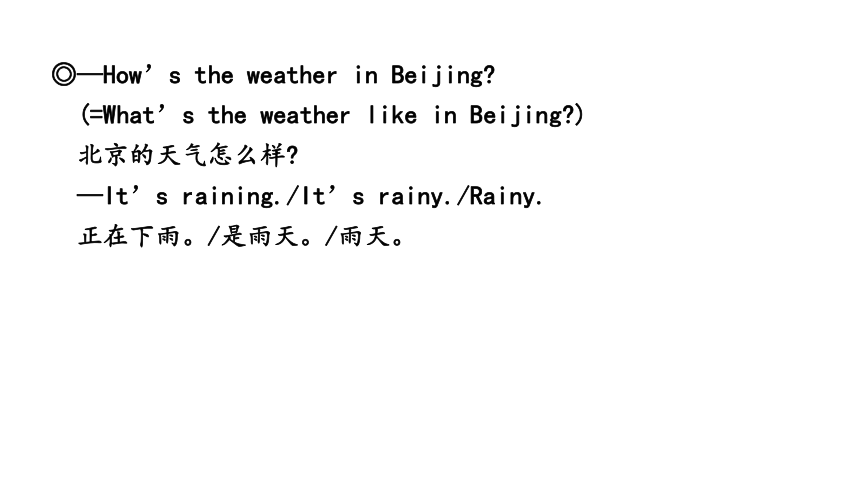
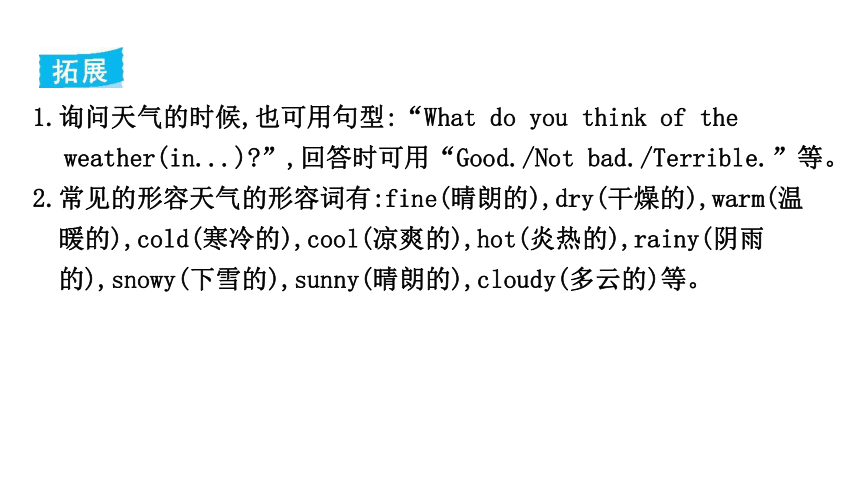

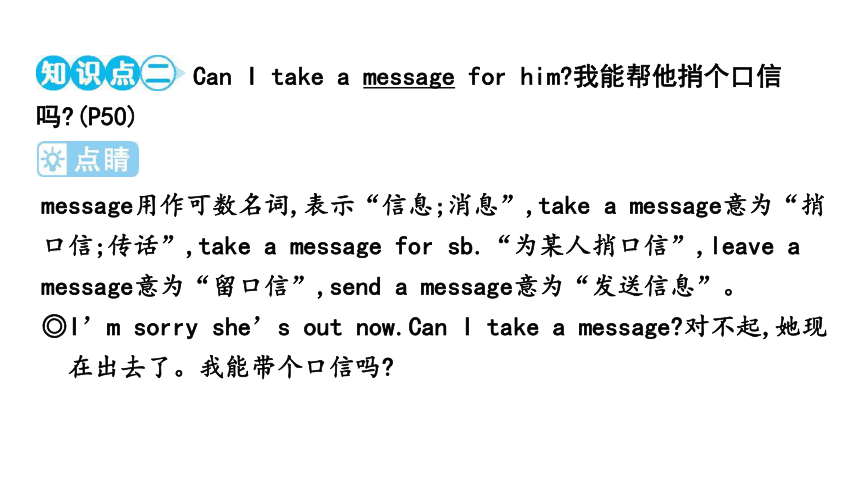
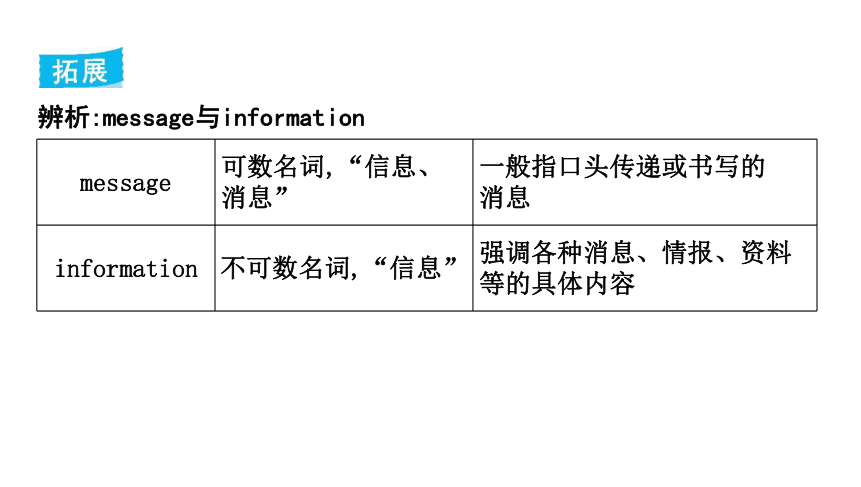
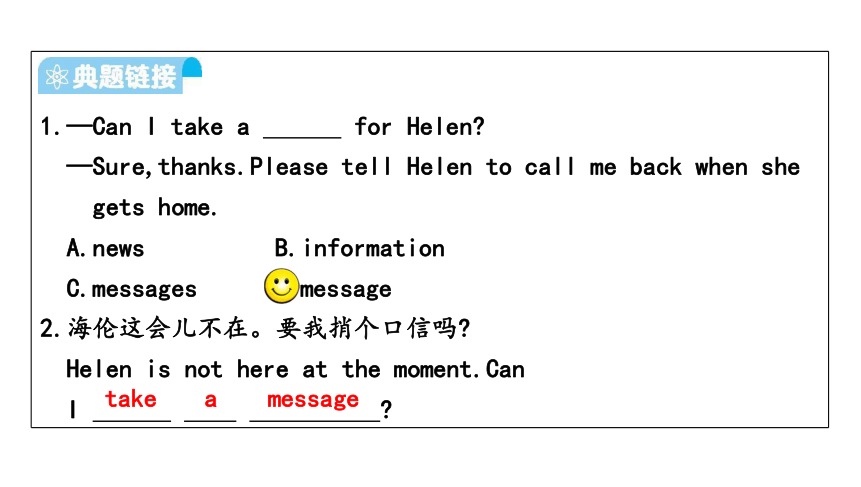

文档简介
(共23张PPT)
Section A
How’s the weather in Shanghai 上海的天气怎么样 (P49)
How’s the weather 意为“天气怎么样 ”,是用来询问天气状况的常用句型,还可以表示为“What’s the weather like ”。询问某地的天气状况时,在句子末尾加介词短语“in +某地”。回答用“It’s+描述天气的形容词.”或直接用描述天气的形容词,也可以用现在进行时进行回答:It’s raining/snowing.正在下雨/下雪。
◎—How’s the weather in Beijing
(=What’s the weather like in Beijing )
北京的天气怎么样
—It’s raining./It’s rainy./Rainy.
正在下雨。/是雨天。/雨天。
1.询问天气的时候,也可用句型:“What do you think of the
weather(in...) ”,回答时可用“Good./Not bad./Terrible.”等。
2.常见的形容天气的形容词有:fine(晴朗的),dry(干燥的),warm(温
暖的),cold(寒冷的),cool(凉爽的),hot(炎热的),rainy(阴雨
的),snowy(下雪的),sunny(晴朗的),cloudy(多云的)等。
1.—What’s the weather like in Moscow
— .
A.Thank you B.I see
C.That’s right D.It’s windy
2.— the weather in your city
—It’s windy.
A.What B.How C.What’s D.How’s
3.It’s cloudy in Beijing.(对画线部分提问)
the weather in Beijing
What’s
like
Can I take a message for him 我能帮他捎个口信吗 (P50)
message用作可数名词,表示“信息;消息”,take a message意为“捎口信;传话”,take a message for sb.“为某人捎口信”,leave a message意为“留口信”,send a message意为“发送信息”。
◎I’m sorry she’s out now.Can I take a message 对不起,她现
在出去了。我能带个口信吗
辨析:message与information
message 可数名词,“信息、 消息” 一般指口头传递或书写的
消息
information 不可数名词,“信息” 强调各种消息、情报、资料等的具体内容
1.—Can I take a for Helen
—Sure,thanks.Please tell Helen to call me back when she
gets home.
A.news B.information
C.messages D.message
2.海伦这会儿不在。要我捎个口信吗
Helen is not here at the moment.Can
I
take
a
message
Could you just tell him to call me back 你能告诉他给我回电话吗 (P50)
1.Could you... 意为“你能……吗 ”,用于委婉地提出请求。Could
为情态动词,比can 更委婉、客气。肯定回答可用:Sure./Of
course./Certainly.“当然可以。”;With pleasure.“很乐
意。”;No problem.“没问题。”,否定回答常用:Sorry,I
can’t.I...抱歉,我不能。我……
◎—Could you go to the movies with me
你可以和我一起去看电影吗
—Sure.当然。(肯定回答)/Sorry,I can’t.I have to do my
homework.对不起,我不能。我得做我的家庭作业。(否定回答)
2.tell的用法
tell tell sb.sth. 告诉某人某事 Please tell me your favorite actor.
请告诉我你最喜欢的演员。
tell sb.about sth.告诉某人关于某事 Let me tell you about our school.
让我告诉你关于我们学校的情况吧。
tell sb.(not) to do sth.告诉某人(不) 做某事 Could you please tell him to come earlier 请你告诉他早点儿来,好吗
3.call sb.back给某人回电话,是“动词+副词”的结构,代词作宾语
时,要放在动词和副词之间;名词作宾语时,可放在动词和副词之间
或副词之后。
◎Please tell your mother I will call her back this
afternoon.
请告诉你妈妈,我今天下午将给她回电话。
1.Could you please (bring) your dictionary to
school
2.My parents always tell me (eat) more vegetables
and fruit.
3.—Could you please turn off the TV
—Sorry,I .(请补充答语)
bring
to eat
can’t
Section B
See you soon.回头见。(P53)
辨析:soon,quickly与fast
soon一般表示时间快速,短促的时间;
quickly一般用作表示动作快速,形容人、车等等;
fast一般表交通工具之类的东西速度快。
1.请尽快给我打电话。
Please call me .
2.他快速跑去学校。
He runs to school .
3.他跑得快。
He runs .
soon
quickly
fast
Are you studying hard,or are you having fun
你学习努力还是很开心 (P53)
hard 作副词时,意为“努力地;艰难地;大量地”;作形容词时,意为“困难的;费力的;坚硬的”
◎Jack works very hard and the boss likes him very much.
杰克工作很努力,老板很喜欢他。
◎It’s raining hard.雨正下得很大。
◎They have a hard life.他们过着艰苦的生活。
hardly 意为“几乎不;几乎没有”,用在实义动词前。
◎It is raining so hard that we can hardly go out.
雨下得这么大,我们几乎出不去。
1.Tom studies ,so he fails the exam.
A.hardly;hardly B.hard;hardly
C.hard;hard D.hardly;hard
2.爸爸经常告诉我要努力学习。
My father often tells me to .
3.这是一项困难的工作。
It is .
study
shard
hard
work
It’s hot in your country now,isn’t it 你们国家现在很热,不是吗 (P53)
这是一个反意疑问句。反意疑问句一般由两部分组成:“陈述句+附加疑问句 ”,用以要求对方证实所述之事。反意疑问句前后两部分必须遵循的原则是“三同一反”,即:人称相同,动词相同,时态相同,前肯后否,前否后肯。
◎—Bill doesn’t want to go shopping,does he
比尔不想去购物,是吧
—Yes,he does./No,he doesn’t.
不,他想。/是的,他不想。
【注意】对反意疑问句的回答要根据实际情况而定。事实为肯定的就用yes 回答,事实为否定的就用no 回答。yes 后面一定跟肯定句,no 后面一定跟否定句。
陈述部分的主句带有never,nothing,hardly,few,little等否定或半否定词时,附加问句一般用肯定式。
◎She has few friends here, does she 她在这里几乎没有朋友,
是吗
速记小法:
反意疑问真好变,前后肯否须相反。有情要用情加主,有be 要用be 加主。若是无情又无be,要用do 主来代替。Let’s go 特殊记,Shall we提前要牢记。
1.—It’s Father’s Day,
—Yes.Let’s buy a gift for Dad.He works very hard for us.
A.isn’t it B.doesn’t it
C.isn’t he D.doesn’t he
2.Sally plays volleyball very well.(改为反意疑问句)
Sally plays volleyball very well,
3.Mike can’t play soccer.(改为反意疑问句)
Mike can’t play soccer,
doesn’t
she
can
he
谢谢观赏!
Section A
How’s the weather in Shanghai 上海的天气怎么样 (P49)
How’s the weather 意为“天气怎么样 ”,是用来询问天气状况的常用句型,还可以表示为“What’s the weather like ”。询问某地的天气状况时,在句子末尾加介词短语“in +某地”。回答用“It’s+描述天气的形容词.”或直接用描述天气的形容词,也可以用现在进行时进行回答:It’s raining/snowing.正在下雨/下雪。
◎—How’s the weather in Beijing
(=What’s the weather like in Beijing )
北京的天气怎么样
—It’s raining./It’s rainy./Rainy.
正在下雨。/是雨天。/雨天。
1.询问天气的时候,也可用句型:“What do you think of the
weather(in...) ”,回答时可用“Good./Not bad./Terrible.”等。
2.常见的形容天气的形容词有:fine(晴朗的),dry(干燥的),warm(温
暖的),cold(寒冷的),cool(凉爽的),hot(炎热的),rainy(阴雨
的),snowy(下雪的),sunny(晴朗的),cloudy(多云的)等。
1.—What’s the weather like in Moscow
— .
A.Thank you B.I see
C.That’s right D.It’s windy
2.— the weather in your city
—It’s windy.
A.What B.How C.What’s D.How’s
3.It’s cloudy in Beijing.(对画线部分提问)
the weather in Beijing
What’s
like
Can I take a message for him 我能帮他捎个口信吗 (P50)
message用作可数名词,表示“信息;消息”,take a message意为“捎口信;传话”,take a message for sb.“为某人捎口信”,leave a message意为“留口信”,send a message意为“发送信息”。
◎I’m sorry she’s out now.Can I take a message 对不起,她现
在出去了。我能带个口信吗
辨析:message与information
message 可数名词,“信息、 消息” 一般指口头传递或书写的
消息
information 不可数名词,“信息” 强调各种消息、情报、资料等的具体内容
1.—Can I take a for Helen
—Sure,thanks.Please tell Helen to call me back when she
gets home.
A.news B.information
C.messages D.message
2.海伦这会儿不在。要我捎个口信吗
Helen is not here at the moment.Can
I
take
a
message
Could you just tell him to call me back 你能告诉他给我回电话吗 (P50)
1.Could you... 意为“你能……吗 ”,用于委婉地提出请求。Could
为情态动词,比can 更委婉、客气。肯定回答可用:Sure./Of
course./Certainly.“当然可以。”;With pleasure.“很乐
意。”;No problem.“没问题。”,否定回答常用:Sorry,I
can’t.I...抱歉,我不能。我……
◎—Could you go to the movies with me
你可以和我一起去看电影吗
—Sure.当然。(肯定回答)/Sorry,I can’t.I have to do my
homework.对不起,我不能。我得做我的家庭作业。(否定回答)
2.tell的用法
tell tell sb.sth. 告诉某人某事 Please tell me your favorite actor.
请告诉我你最喜欢的演员。
tell sb.about sth.告诉某人关于某事 Let me tell you about our school.
让我告诉你关于我们学校的情况吧。
tell sb.(not) to do sth.告诉某人(不) 做某事 Could you please tell him to come earlier 请你告诉他早点儿来,好吗
3.call sb.back给某人回电话,是“动词+副词”的结构,代词作宾语
时,要放在动词和副词之间;名词作宾语时,可放在动词和副词之间
或副词之后。
◎Please tell your mother I will call her back this
afternoon.
请告诉你妈妈,我今天下午将给她回电话。
1.Could you please (bring) your dictionary to
school
2.My parents always tell me (eat) more vegetables
and fruit.
3.—Could you please turn off the TV
—Sorry,I .(请补充答语)
bring
to eat
can’t
Section B
See you soon.回头见。(P53)
辨析:soon,quickly与fast
soon一般表示时间快速,短促的时间;
quickly一般用作表示动作快速,形容人、车等等;
fast一般表交通工具之类的东西速度快。
1.请尽快给我打电话。
Please call me .
2.他快速跑去学校。
He runs to school .
3.他跑得快。
He runs .
soon
quickly
fast
Are you studying hard,or are you having fun
你学习努力还是很开心 (P53)
hard 作副词时,意为“努力地;艰难地;大量地”;作形容词时,意为“困难的;费力的;坚硬的”
◎Jack works very hard and the boss likes him very much.
杰克工作很努力,老板很喜欢他。
◎It’s raining hard.雨正下得很大。
◎They have a hard life.他们过着艰苦的生活。
hardly 意为“几乎不;几乎没有”,用在实义动词前。
◎It is raining so hard that we can hardly go out.
雨下得这么大,我们几乎出不去。
1.Tom studies ,so he fails the exam.
A.hardly;hardly B.hard;hardly
C.hard;hard D.hardly;hard
2.爸爸经常告诉我要努力学习。
My father often tells me to .
3.这是一项困难的工作。
It is .
study
shard
hard
work
It’s hot in your country now,isn’t it 你们国家现在很热,不是吗 (P53)
这是一个反意疑问句。反意疑问句一般由两部分组成:“陈述句+附加疑问句 ”,用以要求对方证实所述之事。反意疑问句前后两部分必须遵循的原则是“三同一反”,即:人称相同,动词相同,时态相同,前肯后否,前否后肯。
◎—Bill doesn’t want to go shopping,does he
比尔不想去购物,是吧
—Yes,he does./No,he doesn’t.
不,他想。/是的,他不想。
【注意】对反意疑问句的回答要根据实际情况而定。事实为肯定的就用yes 回答,事实为否定的就用no 回答。yes 后面一定跟肯定句,no 后面一定跟否定句。
陈述部分的主句带有never,nothing,hardly,few,little等否定或半否定词时,附加问句一般用肯定式。
◎She has few friends here, does she 她在这里几乎没有朋友,
是吗
速记小法:
反意疑问真好变,前后肯否须相反。有情要用情加主,有be 要用be 加主。若是无情又无be,要用do 主来代替。Let’s go 特殊记,Shall we提前要牢记。
1.—It’s Father’s Day,
—Yes.Let’s buy a gift for Dad.He works very hard for us.
A.isn’t it B.doesn’t it
C.isn’t he D.doesn’t he
2.Sally plays volleyball very well.(改为反意疑问句)
Sally plays volleyball very well,
3.Mike can’t play soccer.(改为反意疑问句)
Mike can’t play soccer,
doesn’t
she
can
he
谢谢观赏!
同课章节目录
- Unit 1 When is your birthday?
- Section A
- Section B
- Unit 2 My favourite subject is science
- Section A
- Section B
- Unit 3 Can you play the guitar?
- Section A
- Section B
- Unit 4 What time do you go to school?
- Section A
- Section B
- Unit 5 How do you get to school?
- Section A
- Section B
- Unit 6 Don't eat in class.
- Section A
- Section B
- Unit 7 Why do you like pandas?
- Section A
- Section B
- Unit 8 I'm watching TV.
- Section A
- Section B
- Unit 9 It's raining!
- Section A
- Section B
- Unit 10 Is there a post office near here?
- Section A
- Section B
